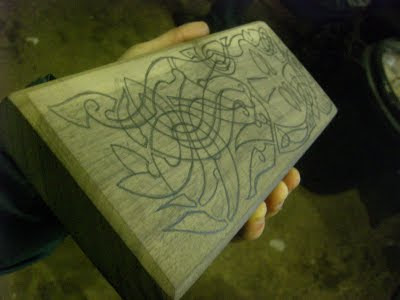So, my class was taught by the unparalleled Jake Powning who, as I've said, is a master of the shape and spirit of Hiberno-Norse artwork (meaning Irish-Viking; from Hibernia , Latin for Ireland, and Norse, referring to those Scandinavians who went a-viking). Here is a sample of his sublime work:

Yes, he forged the blade, and yes, he carved the wax and cast it into bronze. Yes, he is pretty much incredible. I worship his work, but he is, after all, a man.
So here is a picture of him cooking me breakfast:

Stories are for another time. On the first day at 9 AM, we all met outside in the yard of Owen's shop and talked about what we were going to do. Basically, he gave us each a set of six chisels by Lee Valley Tools and a book on Celtic knotwork by George Bain, purely for a source of inspiration. We then went inside and he showed us a presentation he'd prepared on Celtic and Norse ornamentation, called "Chasing the Serpent".
The presentation addressed the apparent origins of knot artwork, in the forms of Pictish beasts (stone carvings of stylized animals from Scotland carved by a pre-Celtic people) and the spirals and naturalistic ornamentation of the "La Tene period", the art and craft of Celtic-speaking peoples living across Europe during the Iron age who eventually migrated into Ireland, bringing iron-making with them.

Next, Jake introduced the art of the Anglo-Saxons. In the centuries surrounding and following the collapse of the Western Roman Empire, millions of Germanic-speaking tribespeople began to migrate south and west of their boggy homelands, by land and by river and by sea, armed with finely wrought swords, nothing to lose and all of Europe to gain. The Angles and Saxons were two tribes living in the Northwest of Germany and southern Denmark, and their hearts led them west to the British Isles, which they swiftly conquered and settled, pushing the Britannic Celts westward where they remain to this day, in Wales and Cornwall. However, in spite of the war and conquest, Anglo-Saxon artwork suffered heavy attrition from the indigenous styles. Already avid craftsmen and incredibly talented artisans, the Anglo-Saxons immediately seized upon the wealth of Celtic art and sought to integrate it into their own treasures. This much is plain from nearly every Anglo-Saxon archaeological find, from Sutton Hoo to the Staffordshire Hoard. The point is, their conquest resulted in a fascinating amalgamation of two strong cultural art traditions, and produced one that has left an indelible mark on history.

We also spent some time looking at pictures of Irish art from the 7th to the 9th century, such as the Book of Kells, which represents the progression of Celtic art unmixed with Germanic influences, although alternately influenced by Christian art of southern Europe. Its illuminated pages show the undying attention to detail of the Celts, and preserve that abstract, surreal reminder of the Otherworld that predates Christianity in Ireland and is an unconquerable theme in Celtic art.
Finally, Jake brought us to Norse artwork. We saw pictures of Viking runestones scattered throughout the British Isles, Scandinavia, northern Europe, and the Baltic, as well as fragments of wood, bone, and horn from graves and bog burials. Most of the ornamentation would have been made on these organic materials, and an unimaginable proportion of it has gone back to the earth, but for the preservative properties of northern European bogland. We also looked at swords, a defining symbol of all Germanic mysticism and an archetype in its own right, as well as other weapons, all decorated with the reverence and beauty befitting a crown or a throne.

The presentation ended with the end of the Viking age, and the dissolution of their culture into the Christian culture that enveloped them. The final stages of the Viking era of artwork and ornamentation is attested in the wonderfully carved and preserved wooden stave churches of Norway and Sweden, where in the 11th and 12th century, the last remaining artisans and products of the Viking age left a final mark of their pride as an homage to the both the old North new North, for cycles and rebirth are the true, deep themes of all their art, from each curving line to the impossible end-products, as well as the true morals of their mythology and the crux of their spirituality.




 I assumed this position often as well, checking for the uniformity of my bevels from the belt grinder. Grinding took probably half as long again as forging, and I used belts of increasing grit, beginning with 60 and going up to 400.
I assumed this position often as well, checking for the uniformity of my bevels from the belt grinder. Grinding took probably half as long again as forging, and I used belts of increasing grit, beginning with 60 and going up to 400. 



































